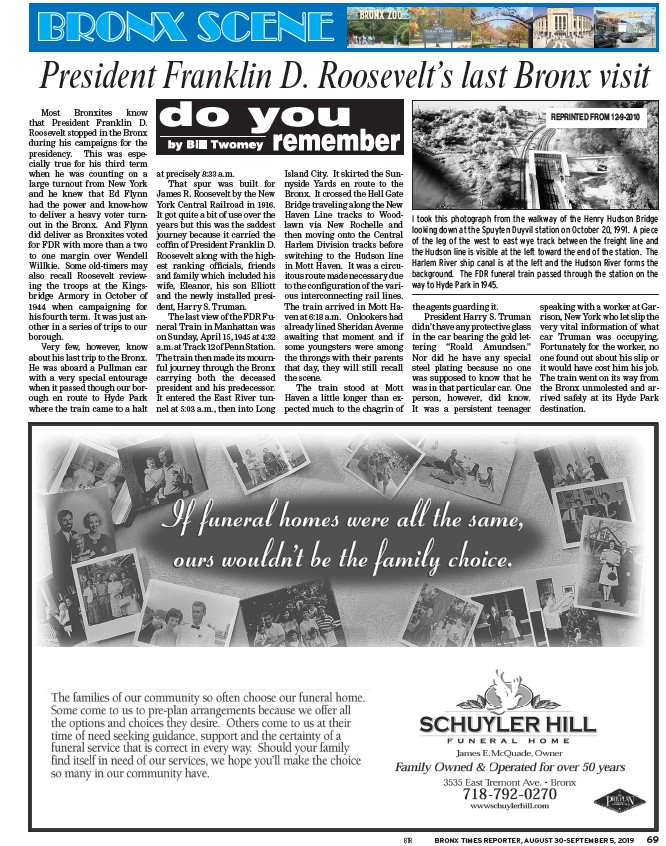
President Franklin D. Roosevelt’s last Bronx visit
REPRINTED FROM 12-9-2010
I took this photograph from the walkway of the Henry Hudson Bridge
looking down at the Spuyten Duyvil station on October 20, 1991. A piece
of the leg of the west to east wye track between the freight line and
the Hudson line is visible at the left toward the end of the station. The
Harlem River ship canal is at the left and the Hudson River forms the
background. The FDR funeral train passed through the station on the
way to Hyde Park in 1945.
BRONX TIMES REPORTER, AUGUST 30-BTR SEPTEMBER 5, 2019 69
Most Bronxites know
that President Franklin D.
Roosevelt stopped in the Bronx
during his campaigns for the
presidency. This was especially
true for his third term
when he was counting on a
large turnout from New York
and he knew that Ed Flynn
had the power and know-how
to deliver a heavy voter turnout
in the Bronx. And Flynn
did deliver as Bronxites voted
for FDR with more than a two
to one margin over Wendell
Willkie. Some old-timers may
also recall Roosevelt reviewing
the troops at the Kingsbridge
Armory in October of
1944 when campaigning for
his fourth term. It was just another
in a series of trips to our
borough.
Very few, however, know
about his last trip to the Bronx.
He was aboard a Pullman car
with a very special entourage
when it passed though our borough
en route to Hyde Park
where the train came to a halt
at precisely 8:33 a.m.
That spur was built for
James R. Roosevelt by the New
York Central Railroad in 1916.
It got quite a bit of use over the
years but this was the saddest
journey because it carried the
coffi n of President Franklin D.
Roosevelt along with the highest
ranking offi cials, friends
and family which included his
wife, Eleanor, his son Elliott
and the newly installed president,
Harry S. Truman.
The last view of the FDR Funeral
Train in Manhattan was
on Sunday, April 15, 1945 at 4:32
a.m. at Track 12 of Penn Station.
The train then made its mournful
journey through the Bronx
carrying both the deceased
president and his predecessor.
It entered the East River tunnel
at 5:03 a.m., then into Long
Island City. It skirted the Sunnyside
Yards en route to the
Bronx. It crossed the Hell Gate
Bridge traveling along the New
Haven Line tracks to Woodlawn
via New Rochelle and
then moving onto the Central
Harlem Division tracks before
switching to the Hudson line
in Mott Haven. It was a circuitous
route made necessary due
to the confi guration of the various
interconnecting rail lines.
The train arrived in Mott Haven
at 6:18 a.m. Onlookers had
already lined Sheridan Avenue
awaiting that moment and if
some youngsters were among
the throngs with their parents
that day, they will still recall
the scene.
The train stood at Mott
Haven a little longer than expected
much to the chagrin of
the agents guarding it.
President Harry S. Truman
didn’t have any protective glass
in the car bearing the gold lettering
“Roald Amundsen.”
Nor did he have any special
steel plating because no one
was supposed to know that he
was in that particular car. One
person, however, did know.
It was a persistent teenager
speaking with a worker at Garrison,
New York who let slip the
very vital information of what
car Truman was occupying.
Fortunately for the worker, no
one found out about his slip or
it would have cost him his job.
The train went on its way from
the Bronx unmolested and arrived
safely at its Hyde Park
destination.
BRONX SCENE